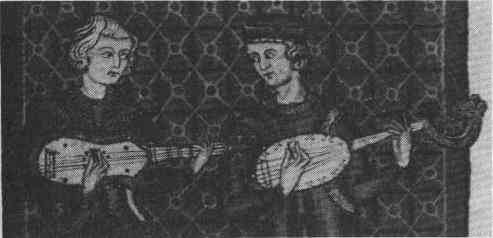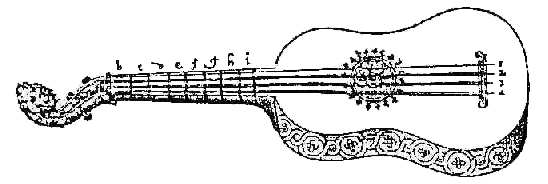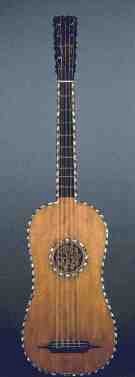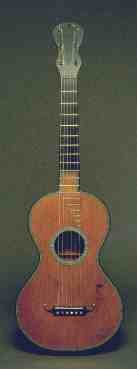
Since the thirteenth century, written sources show that the guitar was used by minstrels in royal courts.
In the fourteenth century, it seems to be played by kings as well as peasants in popular banquets, accompanying feasts and dances
The first printed musics for guitar only appeared in the sixteenth century, some of them can still be seen in libraries

The renaissance guitar has three double courses (pairs) of strings and one single string (n°1 on the top of the drawing)
The tuning of the instrument is not defined by a precise note, but the intervals between courses are fixed.
Music is written in tablatures (not on a staff) as it is in the lute music.
The tablature is a representation of the strings where letters show the fret that has to be used by the left hand.
 means: first open string (letter a);
means: first open string (letter a);
 means: third string, first fret (letter b);
means: third string, first fret (letter b);
 means : second string, third fret (letter d);
means : second string, third fret (letter d);
The right hand technique uses three fingers: thumb, forefinger, middle finger, the little finger staying upon the soundboard
As for the lute, melodic passages are done with thumb and forefinger alternation
Mainly transcriptions from polyphonic vocal pieces, but also dances (pavanas, almains..) and fantasies
Composers are also guitarists and most of them are lutanists too. The most important are: Adrien Le Roy, Alfonso Mudarra, Guillaume Morlaye, Miguel de Fuenllana.

The baroque guitar has five courses. The first course is sometimes double and sometimes single.
There are three main ways of tuning the five courses - from the first to the fifth.
Gaspard Sanz' tuning generally in use in Spain:

Robert de Visée's tuning also maybe generally in use in France:

Girolamo Montesardo's tuning maybe generally in use in Italy:

It is a very complex matter, because the sources that we have on this subjects can be interpreted in different ways- on this subject, you can read an excellent web page by the guitarist Lex Eisenhardt - see the links at the end of this page.
The music notation is still in tablature with a fifth line for the fifth course.
Two main techniques can be found in this period:
punteado: strings played one by one or simultaneously with right hand's thumb, forefinger and middle finger.
razgueado: one or several right hand's fingers slide along the strings to play chords in a rhythmic manner.
Both styles can be used in the same piece
The rest ot the little finger on the soundboard is no more systematic - see iconography above
The books of music published at this time are composed by great virtuosos. They consist of suites of dances.
In France, two great composers work at the Louis XIV's court: Francisque Corbetta and Robert de Visée
In Spain two composers of major importance too are Gaspard Sanz and Santiago de Murcia
Click on the thumbs above to see pictures of the guitar in XVIIth and XVIIIth century paintings

The guitar has six single strings, the tuning is the same as the tuning now in use on modern guitars:

The notation on a staff in tenor-clef is preferred to the tablature
The rest of the little finger on the soundboard disappears progressively, while the ring finger is used more frequently especially when playing arpeggios which is a characteristic technique of this period.
Suites of dances are no more in use; the repertoire is now using the forms in use for other instruments like sonatas, variations and studies - with an important development of a pedagogic material.
Great guitarists of this period are often composers too - like:Fernando Sor, Matteo Carcassi, Fernando Carulli, Napoleon Coste, Dioniso Aguado, Mauro Giuliani, Niccolo Paganini.
Click here to listen to the sound of a Pierre Sylvestre guitar - beginning of XIXth century- in real-audio format (extract from Fernando Sor's largo of fantasy opus 7 by Pierre-Étienne Nataf)
The tuning and the number of stings remains the same as they were in the XIXth century. Meanwhile the body of the guitar becomes larger, and pegs are replaced by roller pegs for a more precise tuning.
The tuning and the number of stings remains the same as they were in the XIXth century. Meanwhile the body of the guitar becomes larger, and pegs are replaced by roller pegs for a more precise tuning.
Technique has to adapt to new languages. New sounds like percussions on the wood or on the strings and Bartok pizzicato are often employed by XXth century composers.
The most important change comes from the specialization of the performer on one side and of the composer on the other side. A lot of composers show interest in the guitar as soloist instrument like Manuel Ponce,Heitor Villa-Lobos, Maurice Ohana, Frank Martin, Léo Brouwer (also performer)..., while some of them use it in chamber music - instrumental and vocal - like Pierre Boulez, Anton Webern, Igor Stravinsky,...
Andrès Segovia was the first to impulse a revival of the guitar, asking many composers to write for his instrument
After him came Ida Presti, Alexandre Lagoya, Julian Bream, John Williams, ...